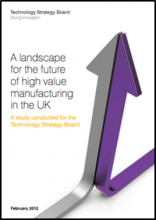Construction Sector Potential for High Value Manufacturing Technologies
BRE coordinated a workshop with Innovate UK and the Institute for Manufacturing a number of key areas were identified where High Value Manufacturing can help the UK construction sector achieve its vision for 2025.  BRE Innovar coordinated a workshop with the Technology Strategy Board and the Institute for Manufacturing a number of key areas were identified where High Value Manufacturing can help the UK construction sector achieve its vision for 2025. The workshop applied the Institute for Manufacturing’s landscaping methodology to explore priorities and gaps for High Value Manufacturing as regards the construction sector.
The report in no way represents a statement of strategy or intent from the Technology Strategy Board but will be used to inform future joint dialogue and engagement between the two sectors. The Technology Strategy Board will also use this output to shape future joint activity and strategy alignment between the priority areas of High Value Manufacturing and Low Impact Building innovation platforms at Technology Strategy Board. The outputs of the workshop are considered to be very useful in identifying areas of common interest and interface challenges between the sectors. Further work will be required to identify areas for investment and support to encourage greater collaboration and alignment between these sectors.
The document is available from the Technology Strategy Board’s _connect platform.
The following Future Products, Process & Services were highlighted where HVM can add value:
On site construction
• Onsite printing of materials and structures
Through life
• BIM requires increased certainty of forecast life asset performance
• Lower cost, reduced maintenance, lightweight products
Offsite construction
• Flexible, modular off-site construction
• Off-site manufacture
Sustainability
• Carbon-neutral buildings
• Non-thermally conducting lintels and junctions in buildings
New materials applications
• Better insulation; thinner and intelligent products for space-saving
Advanced Systems
• Advanced systems for flexible, adaptable, low cost and intelligent buildings (suite of options)
Projects and Construction Management
• Design for manufacturing approach and efficient overall construction with 80% standard range
• Defects incl. energy loss due to poor interface design, construction and maintenance
Participants also identified the following key industrial technologies and capabilities:
Product technology
• Active control ventilation heating and cooling
• Passive environmental control
• Cheaper, stronger, stiffer, more robust composites
• New products to make homes flood resistant
• Better product interfaces, plug & play and tolerances
Enabling technology
• Understanding design stage with HV materials and making them smart
• New and innovating products offering energy efficiency in complex structures
• Better design of more reliable systems
• Performance modelling and standards to accommodate active materials
• Interface modelling
• Encourage collaboration and engagement
Production technology
• Design and manufacture for assembly
Supply Chain
• Business models and supply chain integration
• Reducing procurement inefficiency
• Development, design, specification of new supply chains in UK:
• Manufacturing for offsite construction
• More integrated supply chain
• Tiered modular supply chain
Skills
• Developing know-how in new, niche products
BRE Innovar coordinated a workshop with the Technology Strategy Board and the Institute for Manufacturing a number of key areas were identified where High Value Manufacturing can help the UK construction sector achieve its vision for 2025. The workshop applied the Institute for Manufacturing’s landscaping methodology to explore priorities and gaps for High Value Manufacturing as regards the construction sector.
The report in no way represents a statement of strategy or intent from the Technology Strategy Board but will be used to inform future joint dialogue and engagement between the two sectors. The Technology Strategy Board will also use this output to shape future joint activity and strategy alignment between the priority areas of High Value Manufacturing and Low Impact Building innovation platforms at Technology Strategy Board. The outputs of the workshop are considered to be very useful in identifying areas of common interest and interface challenges between the sectors. Further work will be required to identify areas for investment and support to encourage greater collaboration and alignment between these sectors.
The document is available from the Technology Strategy Board’s _connect platform.
The following Future Products, Process & Services were highlighted where HVM can add value:
On site construction
• Onsite printing of materials and structures
Through life
• BIM requires increased certainty of forecast life asset performance
• Lower cost, reduced maintenance, lightweight products
Offsite construction
• Flexible, modular off-site construction
• Off-site manufacture
Sustainability
• Carbon-neutral buildings
• Non-thermally conducting lintels and junctions in buildings
New materials applications
• Better insulation; thinner and intelligent products for space-saving
Advanced Systems
• Advanced systems for flexible, adaptable, low cost and intelligent buildings (suite of options)
Projects and Construction Management
• Design for manufacturing approach and efficient overall construction with 80% standard range
• Defects incl. energy loss due to poor interface design, construction and maintenance
Participants also identified the following key industrial technologies and capabilities:
Product technology
• Active control ventilation heating and cooling
• Passive environmental control
• Cheaper, stronger, stiffer, more robust composites
• New products to make homes flood resistant
• Better product interfaces, plug & play and tolerances
Enabling technology
• Understanding design stage with HV materials and making them smart
• New and innovating products offering energy efficiency in complex structures
• Better design of more reliable systems
• Performance modelling and standards to accommodate active materials
• Interface modelling
• Encourage collaboration and engagement
Production technology
• Design and manufacture for assembly
Supply Chain
• Business models and supply chain integration
• Reducing procurement inefficiency
• Development, design, specification of new supply chains in UK:
• Manufacturing for offsite construction
• More integrated supply chain
• Tiered modular supply chain
Skills
• Developing know-how in new, niche products

